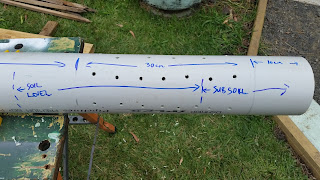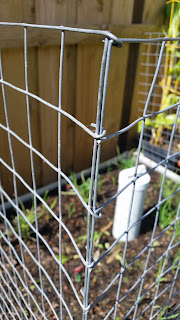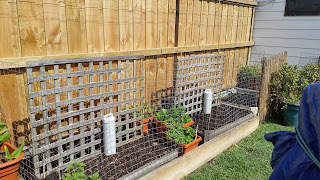Beaming Heat Out To Space
Earth's fever is down to two things - One, greenhouse gases, yep. And fossil fuels, two. Both can be argued to be sides of the one coin, and it can also be argued that we're the ones that flipped it.
Fossil Fuels And Warming
OKAY OKAY I know this is done to death and boring but no - it isn't. Our lives 99% depend on people knowing this, and the young generations' lives will 100% depend on everyone knowing this and being on the same page. Choose your future. . .
Fossil fuels come from . . . well, fossils. The carbon cycle starts when plants use sunlight to split carbon out of CO2 in the air. That carbon is, in effect, the energy that the plant absorbs from the sun, stored as the plant's body. Plants are solar panels that take sunlight and turn it into carbon and are also their own battery, that stores that carbon.
When an animal eats the vegetation, they're just charging up from a solar battery. When an animal eats another animal, they're charging from a power bank. When animals use the energy they've absorbed, they exhale CO2. Which the next generation of plants crack back to carbon and oxygen using solar energy.
Some plants don't get eaten and die naturally, and they take that carbon-stored solar energy into the soil. And when the animals that 'charged' up by eating other carbon-based stuff die, they take energy into the soil. And basically that's what carbon sequestration is. Burying old solar energy.
We burn it (in the form of coal and petroleum products) in fires and smelters and steam engines and vehicles and power stations to make electricity, and burning recombines the carbon with oxygen to make CO2. The trouble is that in doing we're doing damage twice. The energy stored in fossil fuels is extra energy - it was buried down deep and its turn to come back to the surface isn't supposed to be up yet.
And secondly, once CO2 gets aloft in the atmosphere, it traps heat that would normally have been radiated out to space. (In fact, the technologies I'll be mentioning are actually connected to this.) Heat increases, and that's bad because aside from driving planetary temperatures up and making life difficult or downright impossible for various species, there's also a lot more energy being stored in the oceans and the air.
Weather is driven by that heat energy. Each passing day, the overall temperature of everything goes up by a miniscule amount. It might be 0.01C per day or 0.000000001C, but it's currently only going ☝ up. The tiny increments seem ridiculous, but they add up. In the last half a century they've added up to 0.9C, almost a whole degree.
Something like a 0.9C temperature change in a bathtub full of water is only tiny bit of extra energy - but there's a lot more water than that in the oceans, and they're a whole 7,053,400,000,000,000,000 times bigger than a bathtub between them.
(That's a rough guess, bathtubs contain around 50 gallons, the oceans apparently hold around 352,670,000,000,000,000,000 gallons. It's science. I could work it all out but frankly my eyes are sort of glazing over already.)
It's enough to say that the oceans gain a lot of heat energy every day. That creates wilder storms, changes wind and water flow patterns, causes droughts and storms and fires - climate disasters just like we're seeing already.
So that's the situation. We can't wind back the centuries, can't put all that CO2 and carbon back without needing even more energy and releasing even more heat. We need to do something - and actually a lot of somethings - to stop this self-reinforcing cycle. What we can do is the topic today.
How To Get The CO2 Out
Power Generating Plant
It's the obvious target isn't it? Just switch off coal and oil fired power stations.
Just for interest, since setting climate targets for decarbonising (stopping the use of fossil fuels and switching to clean sustainable energy and taking tons of carbon out of the atmosphere) we've hit about . . . around about . . . ummm . . . none of them actually.
So - just switch off coal and oil fired power stations. . .
And replace them . . . with . . . what? That's the problem. Our energy demands keep going up and up as we face hotter weather and so we need more energy-hungry air conditioning, and even though solar farms and wind farms are virtually being thrown up around the world at amazing speed, our energy demand is easily outpacing the rate at which we add capacity.
That's not to say that we should give up. Each new clean energy source we build is another miniscule shift in the right direction. The world gained this energy one miniscule shift at a time, and so this works.
Also, and going back to those oceans: People don't get how BIG the planet is and it takes a lot of energy to shift its overall temperature and will take a lot of effort to shift it back. I'll get back to this a bit further down the article.
Transportation
So - get all vehicles off the roads then. Replace them with hydrogen and battery electric vehicles. Up goes our energy demand to manufacture those cars, and then after that, up goes demand again to keep those vehicles charged and running.
(To their credit, EVs charging off the energy grid are still more efficient - and cause less carbon pollution - than combustion engined vehicles,. mile for mile and year for year. But they are still an energy hog.)
I'll tell you that I think one day we'll just lease vehicles on microleases, you want to go somewhere you tap an app, an EV appears, you go to your destination, the vehicle disappears to go drive someone else - no parking fee, no maintenance costs, just Pay As You Go.
To be balanced, there are also some other problems with this. First you can never keep anything in 'your' car and (fore example) I like to keep a first aid kit, fishing line, and fold up shopping cart plus some solid shopping bags in the car.
And if the person before you was infectious with, oh, say for argument, something like COVID, then you might become ill. Or if you leave your purse or wallet in that car, you have little hope of getting it back.
But I firmly believe that not owning a private car will be necessary. Think of the suburbs, how many acres of driveways are there? And on those driveways sit private cars. For 95% of the day, every day. Rusting, dripping the odd oil, but not being used. This means that you could theoretically use 90% fewer cars if we shared them.
And THAT is why car and fuel companies don't want us to get the sharing EV mindset. They're multiple industries that are currently taking in trillions of dollars - and creating this problem in the first place. They're sitting in the catbird seat, they're successfully taking money from us for fuels and energy and vehicles, and then they're successfully making the recovery our problem so that they don't have to spend any of that hoard. On top of that are whole industries built on top - sales lots, showrooms, garages, petrol stations, and so forth. As I said, it's going to take a LOT to shift the energy equation back into the black.
So, we're seeing adverts for the 'convenience' of owning one or two vehicles apiece, the 'freedom' the vehicles supposedly afford us.
Some of our biggest generators of CO2 are:
Generating electricity, of course. It's a nice low-hanging fruit that means minimal disruption to our 'convenience-based' way of life.
Air travel, shipping, road transport, agricultural, mining, and public transport. Getting more problematic.
Personal transport such as cars and RVs and 4WD not used for work purposes, motorcycles and scooters. Difficult choices.
Petrol engined lawn mowers and line trimmers and hedge trimmers and the like.
There's also a huge amount of materials and work involved in changing all of these over. The ecological cost of digging ever more material up, the energy costs associated with the manufacturing processes.
How To Get The Heat Out
Aircondition less. Yeah I know it sounds a bit glib and pat, but what if you could get the heat out without needing as much energy? Several technologies are coming to the fray. One is a material that beams heat straight through the atmosphere and out into space. There are two links in the last sentence because it's getting wide recognition and thus it shouldn't be long before we see it able to clear heat to infinity and beeeyooonnnd! as Buzz would say.
The next one generates electricity from heat rather than light, and the developers are seeing it as a way to successfully extract more energy from insolation. (Insolation: the incoming solar radiation.) And that's topnotch because it makes use of more of the solar spectrum and gets more energy out of the same acreage of solar panels.
And there's a third candidate that wants to do a thing I can't help but consider to be somewhat problematic, and that's to 'generate electricity from solar panels at night'. But I hasten to add that I'm just not sure - I don't have all the facts.
Okay - the heat mirrors. They're a bit tricky to make - now. But anything like this starts out tricky, just ask any innovator. The first internal combustion engines were cranky, erratic, and prone to all manner of spectacular failures. A few years later they had more or less reliable cars powered with the technology, and Henry Ford was producing cars en masse not long afterwards.
So these are mirrors. But it seems from the description that it retransmits the sun's heat back up at a wavelength that is more able to pass through the air without heating it. So that's a bonus, it reflects more heat out than remains behind.
And these mirrors are also a passthrough element. Put heat in and they retransmits that just the same way. Run cooling pipes against the underside, and it'll suck that heat out, cooling whatever you're running in the system. Use it like an alternative to airconditioning, need to use conventional airconditioning less. And as with everything, someone will figure out how to integrate it into airconditioning units directly, leading to multistorey buildings becoming far more efficient.
Direct rising warm air flwoing up the side of buildings up and under the panels and the heat in that air too will get sent to space and cool air will fall down, cooling the famous 'urban heat islands' that are our cities.
If every city makes a conscious effort to put as much of the urban landscape and buildings under heat mirrors, they'll use less electricity to keep cool.
Next, the device that can extract electricity from heat with almost double the efficiency at which solar panels extract electricity from sunlight. These work better at higher temperatures but luckily we already have great heat pumps, and they can concentrate the heat to these devices.
Moreover, as the article points out, we can easily use solar energy to heat stuff to extreme temperatures already, too. It's the principle behind many of the solar farms you see with a single tower at their centre. If you wanted to store the day's heat in molten salts or some other means, you could run it over these TPV cells and they extract heat, turn it to electricity, and you have a solar power system that runs day and night and through cloudy weather.
Now we come to the one thing I'm not so sure of. I'm fine with recovering waste heat from existing processes. I'm even okay with storing the day's solar energy and using it to do work another time, generating heat in the process. It radiates away during the night, right? And with the heat mirror we can dump some excess heat day and night to balance it out, right?
So this bit from the article gives me doubts:
"We get energy from the sun — it arrives, it warms up the Earth but then the Earth actually radiates the exact same amount of energy back out into space," he says.
That's a balance, right? And because we have excess heat, we already know the balance has changed - in the wrong direction. So why would we want to capture it and store it instead? I'm just not sure. Maybe the heat mirrors will help me get over this doubt.
Thoughts
We have technology, we have resources. What we don't seem to have is to use some of those resources to fix the planet, for what seem to be quite trivial reasons. Maybe we need a good wake-up call, well what do we call successively hotter temperatures, worse fires, worse storms, worse flooding, worse droughts? What do we need, dammit?
And that also brings me to another thought. You may have heard of the Fermi Paradox - scientists, faced with the growing proof that life was probably not an isolated and rare phenomenon, wondering why, if so much life must exist, we haven't seen signs of it yet? (For example, meteorites have been found that have life chemicals embedded in them - how much more proof do we need? Are we really so unwilling to accept anything outside our range?)
And that led other scientists to propose that there's a "Great Filter" event that stops life at some critical point of its development. I think we may be at ours. . .
And also, if that's the case, that industrialisation and resource exploitation are the Great Filter, then one way we should be able to identify any planets that have advanced life on them would be to see if they're emitting more heat than they should be. . .
Conclusion
If we don't act, then Great Filter or not, we're pretty much going to be Filtered anyway, within a generation. Any survivors will get thrown back to a level of civilisation that existed several thousand years ago. Albeit a puzzling one with a lot of puzzling things around them.
Action is called for. YOUR action also. Time to bite the bullet and start making repairs and reparations. I'm happy to start and in fact I've been doing so - reducing my footprint, writing like mad to make people aware, working on means to recycle plastics and other waste materials and keep the out of the waste stream, and writing - did I mention the writing? I do a lot of that, it takes up 75% of my entire week to conceive, research, and write articles.
So please - if you can at all spare some time, take a look at my News Stand where you'll see live updated links to everything I publish; Or take a subscription to my weekly newsletter where you'll receive the same information in your inbox for free; Or contact me via the webform or directly email me; Or donate either directly or at my Ko-Fi page for the price of a coffee, or even make a regular monthly donation there..








